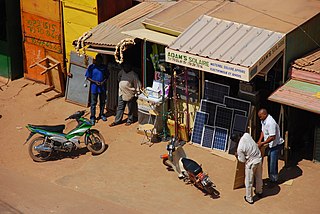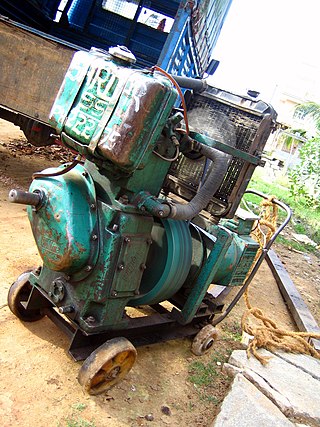
Electric power distribution is the final stage in the delivery of electricity. Electricity is carried from the transmission system to individual consumers. Distribution substations connect to the transmission system and lower the transmission voltage to medium voltage ranging between 2 kV and 33 kV with the use of transformers. Primary distribution lines carry this medium voltage power to distribution transformers located near the customer's premises. Distribution transformers again lower the voltage to the utilization voltage used by lighting, industrial equipment and household appliances. Often several customers are supplied from one transformer through secondary distribution lines. Commercial and residential customers are connected to the secondary distribution lines through service drops. Customers demanding a much larger amount of power may be connected directly to the primary distribution level or the subtransmission level.
Electrification is the process of powering by electricity and, in many contexts, the introduction of such power by changing over from an earlier power source.

Rural electrification is the process of bringing electrical power to rural and remote areas. Rural communities are suffering from colossal market failures as the national grids fall short of their demand for electricity. As of 2019, 770 million people live without access to electricity – 10.2% of the global population. Electrification typically begins in cities and towns and gradually extends to rural areas, however, this process often runs into obstacles in developing nations. Expanding the national grid is expensive and countries consistently lack the capital to grow their current infrastructure. Additionally, amortizing capital costs to reduce the unit cost of each hook-up is harder to do in lightly populated areas. If countries are able to overcome these obstacles and reach nationwide electrification, rural communities will be able to reap considerable amounts of economic and social development.

The Solar Electric Light Fund (SELF) is a non-profit organization whose mission is to design, fund and implement solar energy solutions to benefit those in poor rural communities without access to an electrical grid. This allows students to study at night and brings computers and Internet into schools. It makes it possible to bring in water for irrigation without having to hand-carry it long distances, allowing women to spend their time on money-earning enterprises. Access to electricity and water improves health care. SELF has completed several projects in more than 20 countries including a solar powered drip irrigation in Benin, a health care centre in Haiti, telemedicine in the Amazon rainforest, online learning platform in South Africa, and a microenterprise development in Nigeria.

Off-the-grid or off-grid is a characteristic of buildings and a lifestyle designed in an independent manner without reliance on one or more public utilities. The term "off-the-grid" traditionally refers to not being connected to the electrical grid, but can also include other utilities like water, gas, and sewer systems, and can scale from residential homes to small communities. Off-the-grid living allows for buildings and people to be self-sufficient, which is advantageous in isolated locations where normal utilities cannot reach and is attractive to those who want to reduce environmental impact and cost of living. Generally, an off-grid building must be able to supply energy and potable water for itself, as well as manage food, waste and wastewater.
For solar power, South Asia has the ideal combination of both high solar insolation and a high density of potential customers.

The developing nations of Africa are popular locations for the application of renewable energy technology. Currently, many nations already have small-scale solar, wind, and geothermal devices in operation providing energy to urban and rural populations. These types of energy production are especially useful in remote locations because of the excessive cost of transporting electricity from large-scale power plants. The applications of renewable energy technology has the potential to alleviate many of the problems that face Africans every day, especially if done in a sustainable manner that prioritizes human rights.

Renewable energy in developing countries is an increasingly used alternative to fossil fuel energy, as these countries scale up their energy supplies and address energy poverty. Renewable energy technology was once seen as unaffordable for developing countries. However, since 2015, investment in non-hydro renewable energy has been higher in developing countries than in developed countries, and comprised 54% of global renewable energy investment in 2019. The International Energy Agency forecasts that renewable energy will provide the majority of energy supply growth through 2030 in Africa and Central and South America, and 42% of supply growth in China.

A solar lamp, also known as a solar light or solar lantern, is a lighting system composed of an LED lamp, solar panels, battery, charge controller and there may also be an inverter. The lamp operates on electricity from batteries, charged through the use of a solar photovoltaic panel.

An electrical grid is an interconnected network for electricity delivery from producers to consumers. Electrical grids consist of power stations, electrical substations to step voltage up or down, electric power transmission to carry power long distances, and lastly electric power distribution to individual customers, where voltage is stepped down again to the required service voltage(s). Electrical grids vary in size and can cover whole countries or continents. From small to large there are microgrids, wide area synchronous grids, and super grids.
Sunlabob Renewable Energy is a Lao commercial company that provides sustainable renewable solutions to areas that are off the electrical grid. It was licensed in 2001 and its headquarters and base are in Vientiane, the capital of the Democratic People's Republic of Laos. The company operates as a profitable, full-service renewable energy provider selling hardware and providing commercially viable energy services.
Benin is a coastal country located in the Gulf of Guinea in Western Africa, which is a resource rich region. Energy in Benin has a diverse energy mix and takes several forms including: solar, wind, hydropower, biomass, fossil resources, and mineral resources. Out of this energy mix, about 60% of energy comes from biomass. Benin is also dependent on energy imports from Ghana and Côte d'Ivoire. While power plants and other energy facilities were built in the 1950s and 1960s, the lack of investment has led to deterioration over time. Similarly, its location in the Gulf of Guinea has led to an attempt of oil production starting in the late 1980s. However, due to unprofitable operations, oil production halted in 1998.
Energy in Ethiopia includes energy and electricity production, consumption, transport, exportation, and importation in the country of Ethiopia.
Energy use and development in Africa varies widely across the continent, with some African countries exporting energy to neighbors or the global market, while others lack even basic infrastructures or systems to acquire energy. The World Bank has declared 32 of the 48 nations on the continent to be in an energy crisis. Energy development has not kept pace with rising demand in developing regions, placing a large strain on the continent's existing resources over the first decade of the new century. From 2001 to 2005, GDP for over half of the countries in Sub Saharan Africa rose by over 4.5% annually, while generation capacity grew at a rate of 1.2%.

Most of Kenya's electricity is generated by renewable energy sources. Access to reliable, affordable, and sustainable energy is one of the 17 main goals of the United Nations’ Sustainable Development Goals. Development of the energy sector is also critical to help Kenya achieve the goals in Kenya Vision 2030 to become a newly industrializing, middle-income country. With an installed power capacity of 2,819 MW, Kenya currently generates 826 MW hydroelectric power, 828 geothermal power, 749 MW thermal power, 331 MW wind power, and the rest from solar and biomass sources. Kenya is the largest geothermal energy producer in Africa and also has the largest wind farm on the continent. In March 2011, Kenya opened Africa's first carbon exchange to promote investments in renewable energy projects. Kenya has also been selected as a pilot country under the Scaling-Up Renewable Energy Programmes in Low Income Countries Programme to increase deployment of renewable energy solutions in low-income countries. Despite significant strides in renewable energy development, about a quarter of the Kenyan population still lacks access to electricity, necessitating policy changes to diversify the energy generation mix and promote public-private partnerships for financing renewable energy projects.

The Nigerian energy supply crisis refers to the ongoing failure of the Nigerian power sector to provide adequate electricity supply to domestic households and industrial producers despite a rapidly growing economy, some of the world's largest deposits of coal, oil, and gas and the country's status as Africa's largest oil producer. Currently, only 45% of Nigeria's population is connected to the energy grid whilst power supply difficulties are experienced around 85% of the time and almost nonexistent in certain regions. At best, average daily power supply is estimated at four hours, although several days can go by without any power at all. Neither power cuts nor restorations are announced, leading to calls for a load shedding schedule during the COVID-19 lockdowns to aid fair distribution and predictability.
Concept of smart villages is a global modern approach for off-grid communities. Vision behind this concept is to assist the policy makers, donors and socio-economic planner for rural electrification worldwide.
Luci (lantern) is a LED rechargeable lantern powered by sunlight. The device is inflatable, collapsible, and waterproof, and comprises 10 LED white lights with several settings. The solar-powered artifact became part of a joint campaign with Direct Energy to provide access to lighting to various international rural areas that lack access to electricity.
A mini-grid is an aggregation of electrical loads and one or more energy sources operating as a single system providing electricity and possibly heat, isolated from a main power grid. A modern mini-grid may include renewable- and fossil fuel-based power generation, energy storage, and load control. A mini grid can be fully isolated from the main grid or interconnected to it. If it is interconnected to the main grid, it must also be able to isolate (“island”) from the main grid and continue to serve its customers while operating in an island or autonomous mode. Mini-grids are used as a cost-effective solution for electrifying rural communities where a grid connection is challenging in terms of transmission and cost for the end user population density, with mini-grids often used to electrify rural communities of a hundred or more households that are 10 km or more from the main grid.

Ethiopia has abundant resources that can generate 60,000 TWh electricity from hydroelectric, wind, solar and geothermal sources in the next 10 years. The electrification process causes GDP growth and high public demand for 110 million of its population. On total, Ethiopia produces 14 TWh from all facilities and exports other resources like natural gas or crude oil.











